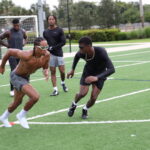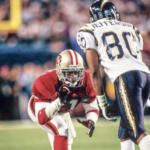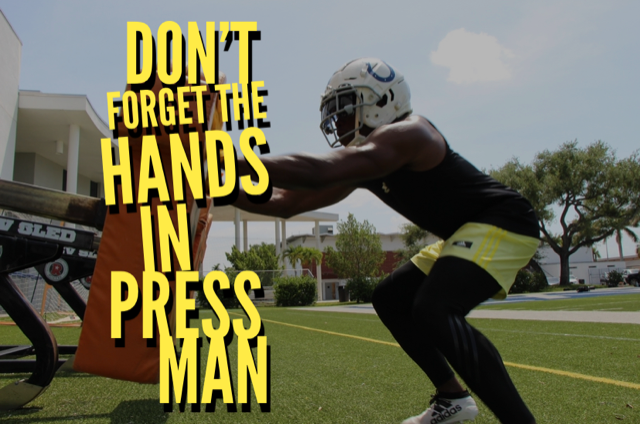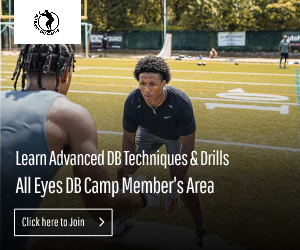Mastering the Art of Press Man Coverage: Techniques Used by Elite Defensive Backs
In the fast-paced world of the football, defensive backs play a pivotal role in disrupting the rhythm of opposing offenses. One of the most effective techniques in a cornerback’s arsenal is the press man coverage. This technique requires precise timing, physicality, and keen awareness to effectively neutralize even the most prolific wide receivers. In this article, we’ll delve into the world of press man coverage, exploring the top techniques employed by elite NFL defensive backs that make them true masters of the art.
Understanding Press Man Coverage
Press man coverage is a defensive strategy where a cornerback lines up close to the line of scrimmage and engages the opposing wide receiver with physical contact at the line. The goal is to disrupt the receiver’s route timing, preventing a clean release off the line and forcing them into unfavorable positions. This tight coverage technique requires a blend of skills, from physical prowess to football IQ.
Key Techniques Employed by Elite Defensive Backs
1. Jamming at the Line
The initial point of contact in press man coverage is crucial. Cornerbacks often use a quick and powerful jam to disrupt the receiver’s release off the line of scrimmage. The jam involves using the hands to redirect the receiver’s path and throw off their timing with the quarterback. Timing is paramount here; mistiming the jam can lead to separation and big plays for the offense. This part of the game has been a lost a little bit over the years as receivers have become more skilled at releasing off of the line of scrimmage. However, their increase in knowledge should not be a deterrent for defensive backs. As the receiver’s skill increases, so too should that of the defensive backs. Double down on training your eye discipline and studying your technique. Free releases should not be a constant thing when playing press man coverage.
2. Mirror and Shuffle
Once the initial jam is successful, elite defensive backs transition into a mirror and shuffle technique. This involves staying in close proximity to the receiver, moving laterally to match their movements, and preventing any separation. The cornerback’s eyes are locked onto the receiver’s hips, allowing them to react quickly to changes in direction. Some defensive backs elect to engage in this technique instead of the jam at the line of scrimmage. This is ok so long as you pair this up with some hard press techniques as well. Quick receivers will eventually eat your lunch if you constantly play a foot game with them. They will plot against your soft press and beat you to the spot. Change things up with an occasional hard press. If you are going to mirror, be sure to train your feet to be efficient and your eyes to be disciplined. You will need those elements.
3. Hand Placement
The placement of the hands is crucial throughout the press man coverage. Defensive backs need to keep their hands on the receiver, without grabbing or interfering illegally. The hands are used to redirect the receiver’s route and maintain leverage. Correct hand placement enables the defender to control the receiver’s movements while remaining in prime position to make a play on the ball. This is an underrated part of press man. Many defensive backs don’t give much thought about exactly how and where to place the hands. Hard jams that does not involve lunging are preferred. The wide receiver must feel the jam and be affected by it. Furthermore, striking the proper part on the wide receiver can do wonders in disruption. I am not one for striking the receiver’s hips. Hips are the strongest part of the body. Instead, strike the chest when at the line of scrimmage and the shoulder as you head down the field. Be leery of keeping your hand on the receiver as you move down the field as they can either use it to throw you by on a route or it can draw a flag from the officials.
4. Hip-to-Hip Positioning
As the play develops, maintaining a hip-to-hip relationship with the receiver is vital. This positioning denies the receiver any space to create separation and effectively reduces the available throwing window for the quarterback. It requires a combination of footwork, balance, and body control to stay in sync with the receiver’s route. This is a key element. Space away from the receiver is ok before the ball is thrown. However, once the ball is released, every effort should be made by the defensive back to get hip to hip with the receiver. This allows the DB to defend a ball thrown to any part of the receiver’s body. This includes balls thrown high and above the defender’s head.
5. Head Turn and Locate
Once the receiver makes his move, a skilled defensive back will execute a smooth head turn to locate the ball. This action allows the cornerback to play the receiver’s eyes and make a play on the ball at the optimal moment. It’s a high-risk, high-reward move that can result in an interception or a pass breakup. One of the biggest mistakes defensive backs make is not looking for the ball. Some DB’s get nervous or forget that the goal is to get the turnover or at the very least prevent the receiver from catching the ball. Both of those outcomes become more likely when the defender can get his head around and see the ball approaching. Understand the situation, your location and if you have help on a play. These factors should cue you in on when you can look for the ball during a route. Grab those interceptions.
6. Recovery Techniques
Press man coverage doesn’t always go as planned, and receivers can occasionally get a step on the cornerback. Elite defensive backs are adept at recovering from these situations using techniques like the “trail technique” or “hip pocket” technique. These methods involve regaining positioning by getting back in close proximity to the receiver, minimizing the chance of a big gain. When you have an IQ that allows you to understand routes and know the defense, you can improve your recovery techniques when things go wrong. If you are beat to the corner of the end zone in Cover 0, you understand that you must now play the wide receiver’s hands. When you are beat in Cover 1 with a route going to the middle of the field, you realize that there’s an opportunity to undercut a route. Keep this in mind when you are playing press.
Press man coverage is an art that requires a combination of physical prowess, football IQ, and technique mastery. Elite defensive backs utilize a variety of techniques, from jamming at the line to hip-to-hip positioning to stifle even the most explosive wide receivers. The precision and skill involved in executing these techniques effectively are what separate the good from the great in the world of defensive backs. Effective studying and honing of your techniques will develop you into an elite defensive back that can use press technique to neutralize the best wide receiver’s that the offense will send your way.
Chad Wilson is the owner of All Eyes DB Camp and author of "101 DB Tips". He played college football at the University of Miami and briefly in the NFL for the Seattle Seahawks. Over his 15 year high school football coaching career, he tutored over a dozen Division I defensive backs and as a trainer has worked with NFL All Pros, first round draft picks, college football All Americans and Top 10 ranked high school football prospects.









